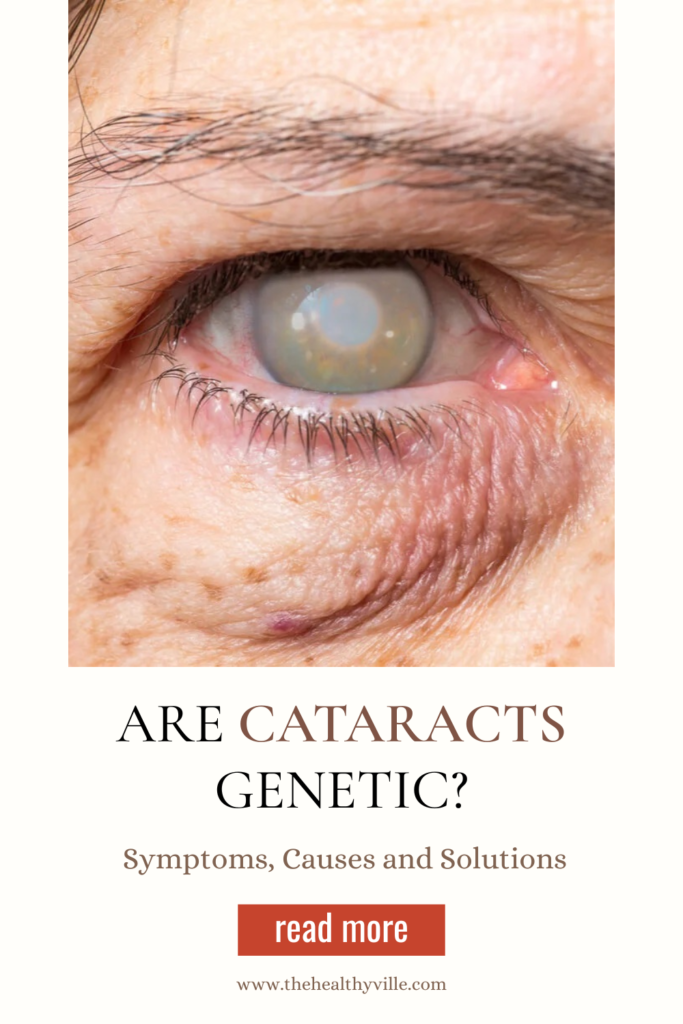Are cataracts genetic? What causes them really? Can you get rid of them easily or do you need surgery? Find out all the answers!
Quitting smoking, avoiding excessive alcohol consumption, wearing glasses with UV protection and having a balanced diet can help partially reduce cataracts.
A cataract patient knows very well what this condition consists of. However, for those who have not experienced the symptoms of advanced cataracts, this disease can be a mystery. Are cataracts genetic? How do you notice them?
According to some sufferers, having them is like looking at everything through a foggy window and never being able to clean it. You can only have a very vague idea of what’s going on behind it. Fortunately, it is possible to alleviate them naturally.
Next, we will discuss the most common symptoms and natural treatments for cataracts.
Are cataracts genetic? What are they really?
The progressive opacity of the crystalline lens, the natural lens of the human eye, is called ‘cataracts’. This translates into a sensation of blurred vision that slowly worsens when it is not treated properly.
So, are cataracts genetic? In fact, the loss of vision mainly affects people over 40 years of age. They are also one of the leading causes of progressive blindness worldwide. Around the age of 40 the biochemistry of the human body begins to change. Proteins that are synthesized by eye cells lose elasticity and harden.
These agglutinate in certain points of the ocular lens. As a consequence, whitish lumps appear that can sometimes be observed in people’s eyes. Falls are the cause of loss of accuracy and visibility at certain distances.
However, these whitish lumps do not appear overnight. This alteration develops gradually, while the eye tries to adapt to this blockage.
The different types of cataracts obstruct light and distort the images that the eye perceives at different angles. For this reason, the symptoms of cataracts will be different between each person who suffers from them.
Types
There are three different types of ocular cataracts, whose names are directly related to the part of the eye they affect. This is what this report from the Mayo Clinic suggests:
-
Subcapsular cataract
This type of cataract is more difficult to identify with the naked eye. Despite this, the patient feels its effects very quickly as the disease develops. People who have diabetes or take steroids in high doses are very prone to this type of pathology.
-
Nuclear cataract
As its name indicates, this type of cataract occurs in the nucleus of the lens. This typology is largely related to aging. In fact, it is the most frequent among men and women aged over 70 years.
-
Cortical cataract
The latter is the most visible to the naked eye. Cortical cataracts are small, opaque, white areas. These opacities can be observed as small wedges located on the periphery of the lens.
-
Congenital cataract
They are suffered by all those children who are born with cataracts or who develop them during childhood. Most of them are related to genetic alterations. So, here’s the answer to the question are cataracts genetic. However, conditions in the mother’s womb and trauma can also cause them.
Symptoms
As we have said before, the symptoms of cataracts can be perceived differently in each person. The symptoms will depend severity and type. However, most of them are characterized by impaired visual acuity, the most notable being the following:
- Cloudy, dim, or blurry vision.
- Hypersensitivity to light, or discomfort when coming into contact with bright lights (such as car headlights).
- Difficulty seeing in dark spaces, in dim light or at night.
- Diffuse vision of the light source, such as lamps and candles.
- Yellowing or discoloration.
- Double vision in one eye.
- Frequent change of prescription in lenses, this means that cataracts are rapidly deteriorating visual health.
- Difficulty reading.
- Need for brighter light to do some activities.
- Worsening of vision on sunny days.
- Difficulty driving at night.
- Increased myopia.
- Sudden improvement of vision in exceptional cases.
At first, cloudy vision affects only a small part of the lens, so it goes unnoticed. However, cataract symptoms become more noticeable as the clouding of the lens grows and distorts the light that passes through it.
When to see the doctor?
The ideal is to consult an ophthalmologist at the slightest change in visual acuity, especially if you are over 40 years of age. However, there are some warning signs among which the following stand out:
- Sudden changes in vision.
- Double vision and sudden flashes of light.
- Acute eye pain.
- Sudden headache.
For their part, the symptoms of cataracts are very similar to the symptoms of less serious eye problems, such as myopia or astigmatism. For this reason, it is necessary that you consult your doctor when you begin to notice two or more of the aforementioned manifestations.
Risk factors
Although cataracts and their symptoms do not have a specific cause, there are a large number of factors that increase the probability of suffering from them. In this sense, the main risk factors include the following:
- Aging.
- Diabetes.
- Excessive exposure to sunlight.
- Smoking and alcoholism.
- Overweight and obesity.
- Arterial hypertension.
- Injury or surgery to the front of the eye.
- Prolonged use of corticosteroids.
In this sense, it is essential to eliminate as many risk factors as possible to reduce the probability of suffering from the disease. Therefore, it is always advisable to maintain good lifestyle habits and always consult a doctor in case of any doubt.
Prevent and relieve cataracts naturally
All experts agree that the only effective treatment for cataracts is their removal through eye surgery. At the moment, there are no other alternatives such as drops, medications or any other type of therapy to cure them.
However, adopting certain lifestyle habits can prevent its appearance and slow down its development. Although there are no conclusive studies at the moment, many doctors and eye doctors strongly recommend it.
-
Avoid harmful habits
Quitting smoking and reducing alcohol consumption are two choices that will improve your quality of life. Although it can be difficult at first, especially because of the social pressure that leads to performing these acts.
According to a study conducted by the Vision Research Foundation (India), tobacco use is related to the appearance of cataracts. It even affects the development of other eye diseases.
Remember that quitting smoking and drinking less will prevent the degeneration of your body. The eyes, like all the organs of the body, will benefit from healthy habits.
-
Maintain a balanced diet
Diet is one of the most important factors in preventing degenerative diseases. A balanced diet helps balance the body and effective self-regulation.
Try to integrate a good amount of varied fruits and vegetables. These have an interesting amount of antioxidants that protect the eyes from degeneration. Vitamins C and E and omega-3 fatty acids are also positive.
-
Protect eyes from sunlight
Prolonged exposure to ultraviolet rays generated by the sun can help the development of cataracts, according to this study from the University of Valladolid. UV rays can affect proteins and other enzymes in the eye, breaking them down and oxidizing them.
Wear dark glasses with proper filters and wide-brimmed hats to protect yourself from harmful UV rays. This is one of the main measures that must be taken into account. According to the American Academy of Ophthalmology, it is also possible to add anti-UV clear coats to commonly used lenses.
-
Look away from the screens
Although at the moment no study has established a connection between radiation from screens and the appearance of cataracts, this is a measure that helps protect visual health in general. For this, it is recommended to situate yourself at a minimum distance of 30 centimeters from devices such as the television, mobile phone or computer.
-
Check the eyes periodically
An eye exam can help detect the problem early and improve its diagnosis and development. For this reason, consult with your doctor about the periodicity of these reviews.
There are some risk factors that could condition its appearance so that individual advice is the best option. Some of these are: family history, age, diabetes, obesity, previous eye treatments or prolonged exposure to the sun without protection.
-
Control the state of health
If you suffer from any of the diseases that increase the risk of cataracts it is important to follow the treatment plan.
Proper lifestyle habits can prevent and improve cataracts
Opacity of the lens (or cataracts) is a highly prevalent ocular pathology, with multiple symptoms and is usually associated with aging. But the good news is that its appearance and development can be stopped with some easy-to-apply lifestyle habits.
If you experience vision problems or any of the 9 most common symptoms of cataracts, do not hesitate to consult your doctor or go to the ophthalmologist. They will be able to agree on the appropriate treatment, as well as recommend some additional guidelines to improve this condition.
Don’t forget to SHARE are cataracts genetic with your friends and family on your social networks!

